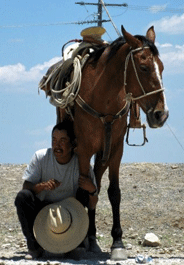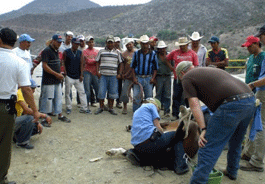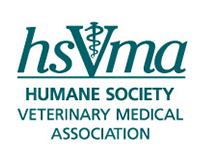Reining in the BurrosOctober 13, 2009 By Flower Marsh Nobody told the burros, mules and horses of Mexico about the country's recent troubles. Although hay and food has become harder to buy for most families, necessity dictates that these people and their animals—who are used to plowing fields, delivering goods, providing transportation and storing wealth—keep working to survive. This spring, HSVMA Field Services spent two weeks in central Mexico, providing free veterinary care in needy, isolated communities that operate largely on traditional agriculture. Beginning each day with a map and a compass, we caravanned in our vehicles to these remote areas, led by local veterinarian Dr. Jose Estrada—affectionately known as "Pepe"—who provided the groundwork and guidance for our group. Mucho, Mucho Burro y Bronco A man waits patiently with his horse. Steven Lonkosky A major problem facing the local people in this area is the feral burros. Huge populations of burros roam the rocky desert landscape, which cannot sustain the many animals that now live upon it. Feral burros come to local farms desiring food and come ready to fight and breed. These untamed burros can injure domesticated burros that are contained or tied, endangering a family's livelihood and leaving the attacked animals injured without veterinary care. The feral burros also create unwanted "burritos," which are frequently set loose out of necessity and further exacerbate the problem. Another challenge these villages face is that intact horses, mules and burros are dangerous to handle. Horror stories are told in every community—of children with chores that involve handling these unpredictable animals or people forced to share narrow mountain trails with them. The locals desperately needed the help of HSVMA Field Services to intervene and castrate some of these burros. The Castration Circus Comes to TownBecause of this great need, a social disturbance would begin to brew each morning with HSVMA's arrival. A mob scene of animals and people would congregate, the numbers becoming larger as observers rushed home to bring more animals, satisfied with what they saw at the clinic.  A crowd gathers to watch Flower castrating a horse. Steven Lonkosky These last minute additions accompanied the herds that had already been waiting since sunrise, many of which had traveled hours over difficult terrain for this event. Such patronage was an immense compliment. That people would trust their livestock, and ultimately their livelihoods, to a group of strangers and foreigners is a true testament to the power that animals have to unite, even across cultures. The esteem that many of these clients held for their working animals, and their gratitude for our care, made for a wonderful experience. At the end of the day, these animals benefitted from surgical and medical procedures—from castration to dental work—that would change their lives dramatically, all in the course of one appointment. And the client education that we provided will likely continue to help the animals we saw—as well as those we did not—long after HSVMA has flown back to the states. Flower Marsh is a veterinary student at Colorado State University. She spent last summer as an intern with HSVMA Field Services, working primarily with our equine program. Her horsemanship and Spanish language skills, in addition to her good humor and dedication, are invaluable. |
